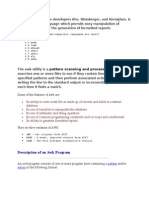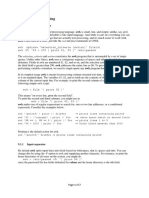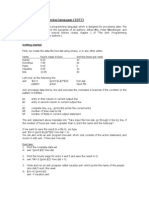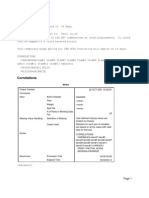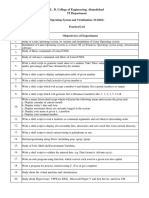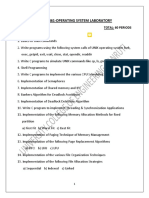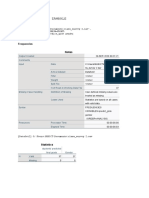Unix Basics and AWK Command Guide
1. Unix Basics
Unix is a powerful, multiuser, multitasking operating system used for servers, desktops, and
laptops. Here are some essential Unix commands and concepts:
1. File and Directory Management:
- ls: List directory contents (e.g., ls -l)
- cd: Change directory (e.g., cd /home/user)
- mkdir: Create directory (e.g., mkdir mydir)
- rm: Remove files/directories (e.g., rm file.txt)
2. File Viewing and Editing:
- cat: View file contents (e.g., cat file.txt)
- more, less: Paginated viewing (e.g., less file.txt)
- nano, vi: Text editors
3. File Permissions:
- chmod: Change file permissions (e.g., chmod 755 script.sh)
- chown: Change file ownership
4. Process Management:
- ps: Show current processes
- top: Dynamic view of processes
- kill: Terminate process (e.g., kill 1234)
5. Redirection and Pipes:
- > : Redirect output to file
- >> : Append output to file
- | : Pipe output to another command (e.g., ls | grep txt)
6. Searching and Filters:
- grep: Search text (e.g., grep "word" file.txt)
- find: Locate files (e.g., find . -name "*.txt")
- sort, uniq, cut, head, tail: Data manipulation tools
2. AWK Command Basics
AWK is a powerful text-processing tool. It scans files line by line, splits each line into fields,
and performs actions.
�Syntax:
awk 'pattern { action }' filename
- FS: Field Separator (default is space; set to '@' for your data)
- NR: Current Record Number (line number)
- $1, $2, ..., $n: Represents fields in a line
3. AWK Command Explanations (Q1–Q16)
Q1: Display all employee names
Command:
awk -F@ 'NR > 1 { print $2 }' employees.txt
Explanation:
This command sets '@' as field separator and processes the file line-by-line according to the
condition specified.
Q2: Sort employee names in ascending order
Command:
awk -F@ 'NR > 1 { print $2 }' employees.txt | sort
Explanation:
This command sets '@' as field separator and processes the file line-by-line according to the
condition specified.
Q3: Sales employees, sorted descending
Command:
awk -F@ 'NR > 1 && $4=="Sales" { print $2 }' employees.txt | sort -r
Explanation:
This command sets '@' as field separator and processes the file line-by-line according to the
condition specified.
Q4: Salary > 60000, print Name and Salary
Command:
awk -F@ 'NR > 1 && $5 > 60000 { print $2 "@" $5 }' employees.txt
Explanation:
This command sets '@' as field separator and processes the file line-by-line according to the
condition specified.
�Q5: Count HR employees
Command:
awk -F@ 'NR > 1 && $4=="HR" { count++ } END { print count }' employees.txt
Explanation:
This command sets '@' as field separator and processes the file line-by-line according to the
condition specified.
Q6: Total salary of all employees
Command:
awk -F@ 'NR > 1 { sum += $5 } END { print sum }' employees.txt
Explanation:
This command sets '@' as field separator and processes the file line-by-line according to the
condition specified.
Q7: Names and ages of employees older than 40
Command:
awk -F@ 'NR > 1 && $3 > 40 { print $2, $3 }' employees.txt
Explanation:
This command sets '@' as field separator and processes the file line-by-line according to the
condition specified.
Q8: Average salary in Marketing
Command:
awk -F@ 'NR > 1 && $4=="Marketing" { sum+=$5; count++ } END { print sum/count }'
employees.txt
Explanation:
This command sets '@' as field separator and processes the file line-by-line according to the
condition specified.
Q9: Minimum salary - print Name and Salary
Command:
awk -F@ 'NR == 2 || $5 < min { min=$5; name=$2 } END { print name, min }' employees.txt
Explanation:
This command sets '@' as field separator and processes the file line-by-line according to the
condition specified.
�Q10: Salary incremented by 10%
Command:
awk -F@ 'NR > 1 { inc = $5 * 1.10; print $2, inc }' employees.txt
Explanation:
This command sets '@' as field separator and processes the file line-by-line according to the
condition specified.
Q11: Sort by salary (ascending)
Command:
awk -F@ 'NR > 1' employees.txt | sort -t@ -k5,5n
Explanation:
This command sets '@' as field separator and processes the file line-by-line according to the
condition specified.
Q12: Display first 3 rows (excluding header)
Command:
awk -F@ 'NR > 1 && NR <= 4' employees.txt
Explanation:
This command sets '@' as field separator and processes the file line-by-line according to the
condition specified.
Q13: Names starting with S
Command:
awk -F@ 'NR > 1 && $2 ~ /^S/ { print $2 }' employees.txt
Explanation:
This command sets '@' as field separator and processes the file line-by-line according to the
condition specified.
Q14: Names ending with a
Command:
awk -F@ 'NR > 1 && $2 ~ /a$/ { print $2 }' employees.txt
Explanation:
This command sets '@' as field separator and processes the file line-by-line according to the
condition specified.
�Q15: Names containing 'y'
Command:
awk -F@ 'NR > 1 && $2 ~ /y/ { print $2 }' employees.txt
Explanation:
This command sets '@' as field separator and processes the file line-by-line according to the
condition specified.
Q16: Names containing vowels
Command:
awk -F@ 'NR > 1 && $2 ~ /[aeiouAEIOU]/ { print $2 }' employees.txt
Explanation:
This command sets '@' as field separator and processes the file line-by-line according to the
condition specified.























